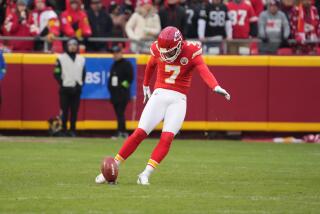Deciding Not to Take a Meeting
- Share via
It’s bound to happen in at least one NFL game this weekend: A team switches to a no-huddle offense, then drives down the field for a score.
It happens all the time, but for some reason, coaches refuse to make this tactic a staple of their offense.
There are so many advantages.
By lining up directly at the line of scrimmage, instead of meeting in a huddle, the offense dictates the flow of the game and gets a chance to tire the opposing defense. Most quarterbacks love no-huddle offenses because they get into a rhythm. They are able to read defenses better because opponents, unable to substitute between snaps, must stay in more basic packages.
Steve McNair, Peyton Manning and Brett Favre are three of the best when it comes to running a no-huddle offense, but the league is full of capable quarterbacks.
New England’s Tom Brady gave Denver a taste of his leadership ability, directing a no-huddle Monday. New Orleans’ Aaron Brooks has led the Saints to three victories in four weeks since they began using the attack more often. And let’s not forget last season’s Super Bowl, which featured Tampa Bay’s Brad Johnson ripping Oakland’s defense with a no-huddle offense.
A no-huddle offense is basically the same as a two-minute attack, but without the panic. When teams are in a two-minute offense, the offense is trying to score in a hurry while preserving time on the clock. Hall of Famers Johnny Unitas and Roger Staubach were kings in this department.
There are two basic ways to use a no-huddle attack:
* The most common reason is to speed the game up. Offenses do this by turning to spread passing formations, hoping to exploit mismatches and holes in the secondary. Having the quarterback in a shotgun formation helps him read coverages and gets his offense into the right play to run.
* Then there’s the hurry-up-and-wait approach. Instead of running plays in quick succession, an offense simply lines up at the line of scrimmage, then allows the play clock to run down before snapping the ball. This prevents a defense from making changes and allows offensive players to rest between snaps.
Today’s no-huddle offenses are a lot different from what they were years ago, when legendary Coach Bud Wilkinson popularized Oklahoma’s “Go-Go” offense in the 1950s.
Wilkinson’s quick-hitting teams ran opponents ragged, but no team has ever dominated in the NFL using the no-huddle approach full-time.
The first team to give it a try was Sam Wyche’s 1985 Cincinnati Bengals. They operated frequently without a huddle and Boomer Esiason passed for 27 touchdowns, but the Bengals finished 7-9.
For the next decade, more NFL teams began to toy with the approach, and then the Buffalo Bills made it the staple of their offense in the late 1980s under Coach Marv Levy.
With quarterback Jim Kelly orchestrating the Bills’ no-huddle attack, Buffalo went from an also-ran to perennial Super Bowl contender. Running back Thurman Thomas and wide receivers Andre Reed and James Lofton flourished in Levy’s up-tempo offense and the Bills reached the Super Bowl in four consecutive seasons.
But when Buffalo’s successful run came to an end in the mid-1990s, the Bills’ no-huddle attack was just a shell of its former self.
The main reason more teams don’t switch is that NFL defenses always catch up to new wrinkles ... eventually -- from Tom Landry’s shotgun attack with Dallas to Joe Gibbs’ power-running offense with Washington to Mike Martz’s high-powered passing schemes with St. Louis.
It also doesn’t help that no-huddle offenses take a lot of work to perfect because there are so many plays available. Eventually, though, a team runs out of material, which allows defenses to catch up.
Once a crack is exposed in such an attack, success usually ends. That’s why the good teams that still use the no-huddle offense use it sparingly.
More to Read
Go beyond the scoreboard
Get the latest on L.A.'s teams in the daily Sports Report newsletter.
You may occasionally receive promotional content from the Los Angeles Times.










